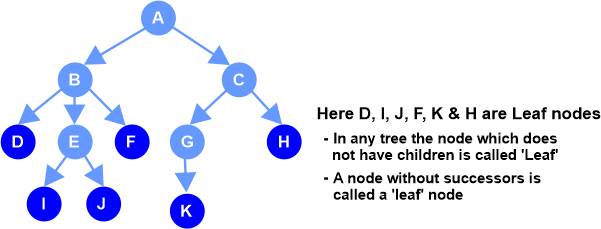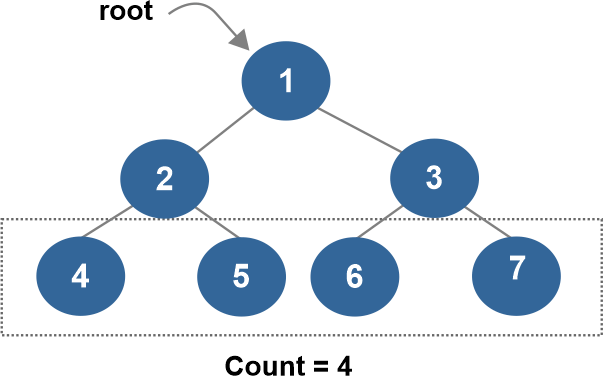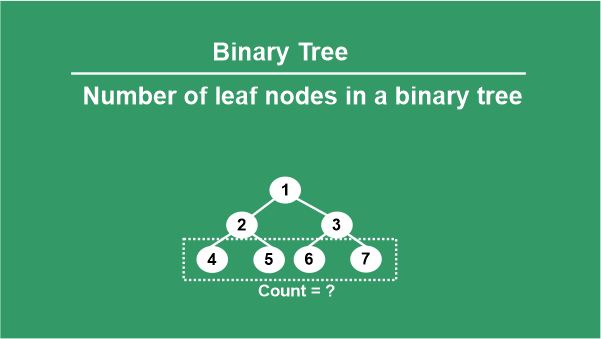Binary Tree Leaf Nodes
The data structure and algorithm (DSA) in computer programming language is very important for programmer for solving up of the problem, also, data structure plays major role. The TREE is a part of Data Structure which is of non- linear nature and is represented in hierarchal form.
In a binary tree, a leaf node is a node that does not have any children. It is a node that does not have any branches extending from it, and it is the farthest point from the root in the tree. A leaf node typically contains a data value or some other information. It means, a leaf node is a node in a tree data structure that has no children. Leaf nodes are also sometimes referred to as terminal nodes.

One disadvantage of leaf nodes is that they have limited capability for storing and processing data. Since they do not have any children, they cannot store additional data or perform additional processing beyond what is contained in the leaf node itself. This can be a limitation when working with large amounts of data or when performing complex tasks. In a binary tree, each node has at most two children, a left child and a right child. If a node doesn't have any children, it is considered as a leaf node. Leaf nodes are also sometimes referred to as "terminal nodes."
For example, consider the following binary tree for knowing the leaf node of it as:
Figure: View of Leaf node of Binary Tree
10 (parent node)
/ \
12 15 (c=Child node)
/ \ / \
2 5 7 8 ( leaf Node)
In this tree, the nodes 2, 5, 7, and 8 are leaf nodes, because they do not have any children. The other nodes (10, 12, and 15) are not leaf nodes because they have children.
Leaf nodes are important in a binary tree because they represent the end of a branch. They are also useful for traversing the tree and performing various operations on the data stored in the tree. The leaf nodes play an important role in the binary tree structure because they represent the end of the branches in the tree and they contain the data that is stored in the tree. The data stored in a binary tree can be anything, such as numbers, strings, or even objects, depending on the application. In algorithms that traverse a binary tree, the leaf nodes are typically the last nodes that are visited, and they often play a key role in determining the result of the algorithm.

Figure: Leaf node of Binary tree
For example, in this figure binary tree structure the Node 1 is the root node ( as parent node) and Node 2 and Node 3 are the children node of root node 1 and the last node of tree as Node 4 and Node 5 and Node 6 and Node 7 are the leaf node of this binary tree.
Features of Leaf node of Binary Tree
- In the context of data structures and algorithms, a leaf node is a node in a tree that has no children. It is a terminal node, meaning that it is the end of a branch in the tree. A leaf node may contain data or it may be empty, depending on the specific tree structure and the purpose of the tree.
- In some tree structures, leaf nodes are used to store data, while in others they are used as placeholders to mark the end of a branch. These leaf nodes represent the end of the branches in the tree and they don't have any further branches leading from them. That's why they are called "leaf nodes."
- The data stored in these nodes is what the binary tree is designed to hold, and it can be anything depending on the specific use case. For example, the values stored in the leaf nodes could represent the results of a calculation, or the values of variables in a program. In algorithms that traverse the binary tree, the leaf nodes are typically the last nodes that are visited, and they often play a key role in determining the result of the algorithm.
- Leaf nodes are important in tree structures because they provide a way to identify the end of a branch, which is important for many tree-based algorithms. For example, in a search tree, leaf nodes can be used to indicate that a search has reached the end of a branch and no further action is needed.
- Leaf nodes can also be used in other types of data structures, such as linked lists and graphs, to mark the end of a chain or path.
Example:

In this binary tree, the leaf nodes are the nodes with the values 4, 5,6,and 7. These nodes don't have any children and represent the end of the branches in the tree. The data stored in these nodes could represent, for example, the results of some calculation or the values of some variables in a program.
Each node in a binary tree has at most two children, a left child and a right child. The root node of the binary tree in the example is 1, which has two children, 2 and 3. The node 2 has a left child with the value4 and 5, and the node 3 has two children, 6 and 7. These nodes are the end points of the branches in the tree and don't have any children.
There are several advantages to using leaf nodes in data structures and algorithms, leaf nodes are useful and important feature in many data structures and algorithms, and they can help to make these structures more efficient, flexible, and easy to work with the programming paradigm and problem solving.